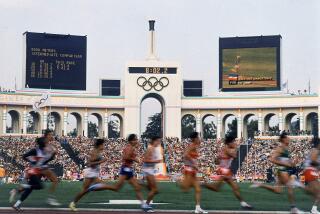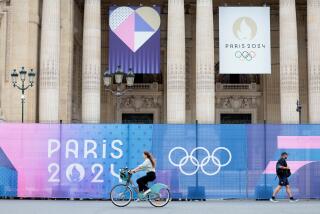Pan American Games : Havana Did It With No Frills
HAVANA — It is important to maintain perspective here, where life’s basic needs are usually met, but seldom ever in the style that much of the world has come to expect. Cuba works as well as it needs to, the expectations of others notwithstanding.
So it is that the word that best describes Cuba’s readiness to host the 11th Pan American Games is adequate. To the surprise of many--including the president of the U.S. Olympic Committee--nearly every venue is ready to accommodate 6,000 athletes from 32 countries in North, Central and South America and the Caribbean for the Games that begin Saturday.
The venues may not stand up well to close scrutiny--indeed, they may not even be standing 10 years from now--but they meet the minimum international standards required for the event. Few, however, meet standards that would be acceptable elsewhere.
“A year ago, a lot of us thought it would not be possible for the Pan American Games to be held here,” USOC President Robert Helmick said Tuesday. “Between January and now, we’ve been pleasantly surprised.”
What Helmick and a USOC delegation saw in January did not inspire confidence. There was no track at the velodrome, the work was far from finished at the 35,000-seat main stadium, and the only sign of progress at the swimming venue was the construction of one wall and a muddy hole in the ground. Everywhere, signs of Cuba’s economic morass were evident, and the Games’ organizing committee spent much time assuring delegations of sports officials that the work would be completed.
How much did it cost a country with a crumbing economy to add these expensive sports facilities? Cuban officials will not say and even if such a figure were available, it would have little meaning. How do you estimate the cost of “volunteer” labor and the work of thousands of “micro brigades,” made up of government clerks, students, technicians and some world-class athletes?
In any event, the facilities have been finished.
“We are here to compete in the Games,” Helmick said, “not to comment on the sacrifices that have been imposed on the Cuban people.”
It was the pool, in particular, that disturbed Helmick, a past president of the international swimming federation. He said in January that it was all but impossible for the ambitious project to be finished on time. Well, call it a miracle. A tour Tuesday of the five new facilities revealed that the construction effort that mobilized thousands of workers has paid off.
The new buildings are largely finished and the improvement of the existing sports facilities is nearly done. They might not have the amenities many outside of Cuba expect--such as shower heads in the locker rooms, or any form of landscaping other than mounds of dirt around the new buildings--but the games will go on.
“We have modest ideas about the facilities here,” said Antonio Aguilera Sanchez, an official at the boxing venue in Old Havana. “This is to our standards. It is not to the standards of other countries. To other countries, Japan, to name one, this is not (good) enough. The Japanese would look at this and say, ‘First thing, we need two bulldozers. Start here (pointing to the front of the building) and finish here (pointing to the back of the building).’ But for us, this is good enough. It is to our standards.”
The new swimming complex, situated near a cluster of other venues in east Havana, is the country’s first and only indoor pool. It has been an ambitious venture.
According to Francisco Gutierez, the financial supervisor for the pool’s construction, it has taken 950 laborers working around the clock since February to complete the project. And on Tuesday, Gutierez was still overseeing the final touches. Such as filling the 50-meter competition pool with water. A leak developed in an underwater photographer’s window and the pool had barely a foot of water in it.
The adjoining 25-meter practice pool was filled, in fact it was overfilled and was being drained. The diving well was likewise sloshing with water, which, divers complained, was cold and dirty.
“They say it’s going to get fixed tomorrow, just like the lights,” said Victoria Alberty of Puerto Rico, who was standing in the half-light that filtered from the glass doors lining the entire building. “Overall, the facilities are good. But I’ve been diving everywhere. I’m used to everything.”
From the pool, it is a short walk across open fields to the velodrome. Sidewalks are in place in some areas but most remain unfinished. These vast open areas, which also connect the velodrome to the new tennis center, are an example of Cuban ingenuity. Huge boulders were unearthed during construction but the workers had no way to pulverize them. Instead, they rolled them to several areas and created rock gardens and sculpture-like scenes. Cast-iron iguanas were put among some boulders to complete the effect.
Nearby, the velodrome is modern, with a track laid down in January by experts from what used to be East Germany. The scoreboard, like those at other venues, is Mexican-made. A curious intrusion of capitalism is apparent on the concrete track. Painted on the steep banks are the logos of numerous cycling manufacturers.
At the huge track stadium there was another water problem--puddles in the entrance and all of the underground portions of the stadium. The roof was leaking and small lakes were forming in the buildings’ offices, much faster than workers with mops--poles with rags at the end--were able to absorb them.
Many venues were simply refurbished. The preliminary boxing rounds are being held in such a place, an ornate old building that was built in the mid-1800s as Havana’s first hotel. It has been renamed Kid Chocolate, after the former bantamweight world champion, Cuban Eligio Sardinas.
Inside it is dark and close and the atmosphere is typically Cuban; it feels like a sauna. Boxing is one of the most popular sports in Cuba, and sellouts are a certainty in this smallish 3,000-seat arena.
“It will be--not cooler--but less hot,” Aguilera Sanchez said.
Like the facilities: Done. But not finished.
More to Read
Go beyond the scoreboard
Get the latest on L.A.'s teams in the daily Sports Report newsletter.
You may occasionally receive promotional content from the Los Angeles Times.







